船舶试航大纲(总体,中英)
- 格式:pdf
- 大小:155.54 KB
- 文档页数:11

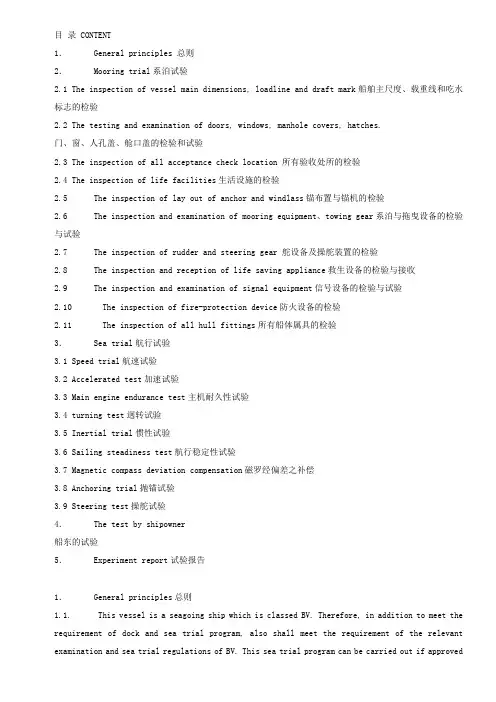
目录 CONTENT1.General principles 总则2.Mooring trial系泊试验2.1 The inspection of vessel main dimensions, loadline and draft mark船舶主尺度、载重线和吃水标志的检验2.2 The testing and examination of doors, windows, manhole covers, hatches.门、窗、人孔盖、舱口盖的检验和试验2.3 The inspection of all acceptance check location 所有验收处所的检验2.4 The inspection of life facilities生活设施的检验2.5 The inspection of lay out of anchor and windlass锚布置与锚机的检验2.6 The inspection and examination of mooring equipment、towing gear系泊与拖曳设备的检验与试验2.7 The inspection of rudder and steering gear 舵设备及操舵装置的检验2.8 The inspection and reception of life saving appliance救生设备的检验与接收2.9 The inspection and examination of signal equipment信号设备的检验与试验2.10 The inspection of fire-protection device防火设备的检验2.11 The inspection of all hull fittings所有船体属具的检验3.Sea trial航行试验3.1 Speed trial航速试验3.2 Accelerated test加速试验3.3 Main engine endurance test主机耐久性试验3.4 turning test迥转试验3.5 Inertial trial惯性试验3.6 Sailing steadiness test航行稳定性试验3.7 Magnetic compass deviation compensation磁罗经偏差之补偿3.8 Anchoring trial抛锚试验3.9 Steering test操舵试验4.The test by shipowner船东的试验5.Experiment report试验报告1.General principles总则1.1. This vessel is a seagoing ship which is classed BV. Therefore, in addition to meet the requirement of dock and sea trial program, also shall meet the requirement of the relevant examination and sea trial regulations of BV. This sea trial program can be carried out if approvedby BV and shipowner.本船为入级BV之海船,因此,除满足本系泊与航行试验大纲外,也应满足BV有关检验和试航的规则,此试验大纲需经BV及船东认可方能执行。
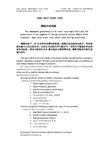
DEAD SHIP START TEST瘫船启动试验The emergency generator to be start auto martially and the propulsion to be capable of being restored within 30min afterblackout. Dead ship start test shall done during seatrials.瘫船状态下,在30分钟内用蓄电池组第二能源启动应急发电机后,用应急配电板向主空压机供电,启动主空压机向空气瓶充气,再用空气瓶逐步启动柴油发电机组。
然后主配实行并车,最后起动主推进器电机. 瘫船试验应在航行试验中进行.This test is done to show the ability of the ship to remain operational from emergency situation operating on battery. All battery sets should be simulated empty, by switching off main battery breaker until charger is powered.这个试验应该做在应急状态下通过第二能源蓄电池恢复船舶供电能力.所有蓄电池容量应模拟是空的,从主开关切换直到充电.At the end of the test the duration will be recorded.测试持续时间应该被记录General conditions: Vessel on battery, Emergency generator stopped一般状态:应急发电机蓄电池准备,应急发电机停止1- Switch battery group N°2 on2- Start Emergency generator3- Switch on Emergency Switchboard4- Start Air compressor N°21- 蓄电池转换开关打到第二组能源2- 起动应急发电机3- 合闸应急配电板开关4- 起动二号主空压机Once the pressure in Starting air bottle is ok, carry on the procedure一旦起动空气瓶压力达到;执行下列程序:5- Start Main Diesel Generator (N°1,2 ,3or 4)6- Switch on Main Switchboard7- Start all propulsion system5- 起动主发电机(#1,2,3,或4)6- 合闸主配电板开关7- 起动主推进装置At this point, the test is finished and the duration is recorded.测试持续时间应该被记录Testing of independency between main and emergency electrical system主电源和应急电源切换试验.General comments:Owner representative Shipyard representative DNV representative。
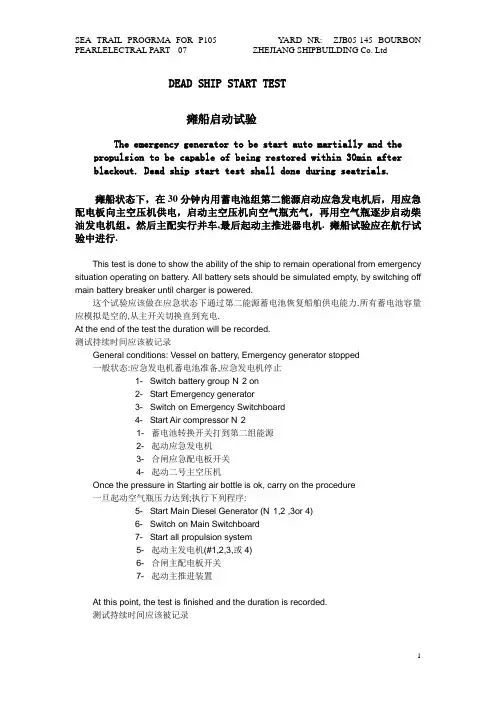
DEAD SHIP START TEST瘫船启动试验The emergency generator to be start auto martially and the propulsion to be capable of being restored within 30min afterblackout. Dead ship start test shall done during seatrials.瘫船状态下,在30分钟内用蓄电池组第二能源启动应急发电机后,用应急配电板向主空压机供电,启动主空压机向空气瓶充气,再用空气瓶逐步启动柴油发电机组。
然后主配实行并车,最后起动主推进器电机. 瘫船试验应在航行试验中进行.This test is done to show the ability of the ship to remain operational from emergency situation operating on battery. All battery sets should be simulated empty, by switching off main battery breaker until charger is powered.这个试验应该做在应急状态下通过第二能源蓄电池恢复船舶供电能力.所有蓄电池容量应模拟是空的,从主开关切换直到充电.At the end of the test the duration will be recorded.测试持续时间应该被记录General conditions: Vessel on battery, Emergency generator stopped一般状态:应急发电机蓄电池准备,应急发电机停止1- Switch battery group N°2 on2- Start Emergency generator3- Switch on Emergency Switchboard4- Start Air compressor N°21- 蓄电池转换开关打到第二组能源2- 起动应急发电机3- 合闸应急配电板开关4- 起动二号主空压机Once the pressure in Starting air bottle is ok, carry on the procedure一旦起动空气瓶压力达到;执行下列程序:5- Start Main Diesel Generator (N°1,2 ,3or 4)6- Switch on Main Switchboard7- Start all propulsion system5- 起动主发电机(#1,2,3,或4)6- 合闸主配电板开关7- 起动主推进装置At this point, the test is finished and the duration is recorded.测试持续时间应该被记录Testing of independency between main and emergency electrical system主电源和应急电源切换试验.General comments:Owner representative Shipyard representative DNV representative。
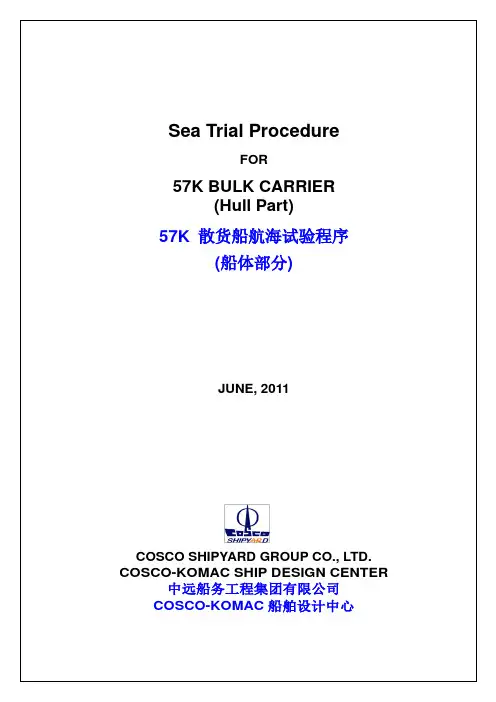
COSCO SHIPYARD GROUP CO., LTD.CONTENTS1.GENERAL INFORMATION 总则 (4)1.1INTENTION 目的 (4)1.2DATE AND PLACE 日期和地点 (4)1.3PRINCIPAL PARTICULARS 主要参数 (4)1.4GENERAL概述 (5)1.5DRAFT MEASUREMENT 吃水测量 (6)1.5.1CONDITION OF THE SEA TRIAL航海试验条件 (6)1.5.2OBSERVATION观测 (6)2.OFFICIAL SEA TRIAL正式航海试验 (8)2.1SEA TRIAL CONDITION 航海试验条件 (8)2.2SCHEME OF SEA TRIAL 试验方案 (9)2.3PROCEDURE OF TEST 试验程序 (9)2.3.1PROGRESSIVE SPEED TEST 测速试验 (10)2.3.2CRASH STOP ASTERN TEST紧急停车倒车试验 (13)2.3.3INERTIA STOPPING TEST惯性试验 (15)2.3.4COURSE KEEPING TEST 航向稳定性试验 (16)2.3.5STEERING GEAR TEST 操舵试验 (17)2.3.6ANCHORING TEST抛锚试验 (21)2.3.7RESCUE BOAT TEST 救助艇试验 (24)2.3.8FREE FALL LIFEBOAT TEST 自由抛落救生艇试验 (27)1. GENERAL INFORMATION 总则1.1 INTENTION 目的The sea trial shall be carried out to demonstrate operation and performance of the vessel and to confirm that all requirement of the contract have been complied with.进行航海试验的目的在于验证船舶的性能,并确保其满足合同要求。
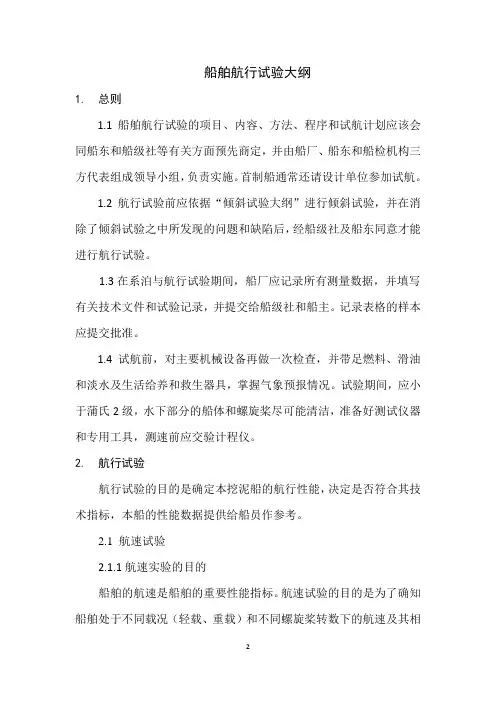
船舶航行试验大纲1. 总则1.1船舶航行试验的项目、内容、方法、程序和试航计划应该会同船东和船级社等有关方面预先商定,并由船厂、船东和船检机构三方代表组成领导小组,负责实施。
首制船通常还请设计单位参加试航。
1.2航行试验前应依据“倾斜试验大纲”进行倾斜试验,并在消除了倾斜试验之中所发现的问题和缺陷后,经船级社及船东同意才能进行航行试验。
1.3在系泊与航行试验期间,船厂应记录所有测量数据,并填写有关技术文件和试验记录,并提交给船级社和船主。
记录表格的样本应提交批准。
1.4试航前,对主要机械设备再做一次检查,并带足燃料、滑油和淡水及生活给养和救生器具,掌握气象预报情况。
试验期间,应小于蒲氏2级,水下部分的船体和螺旋桨尽可能清洁,准备好测试仪器和专用工具,测速前应交验计程仪。
2. 航行试验航行试验的目的是确定本挖泥船的航行性能,决定是否符合其技术指标,本船的性能数据提供给船员作参考。
2.1 航速试验2.1.1航速实验的目的船舶的航速是船舶的重要性能指标。
航速试验的目的是为了确知船舶处于不同载况(轻载、重载)和不同螺旋桨转数下的航速及其相应的主机功率、螺旋桨推力,从而求得转数、航速、功率和推力间的关系。
2.1.2试航条件(1)试航中,船舶的装载状态和首尾吃水应尽可能符合本船的设计状态,排水量误差允许±3%,(2)应有足够的航距,以保证船舶有一稳定的航程和船舶进入测速区测速前主机有一稳定的转速。
(3)航速试验应在天气条件良好下进行,而且水流平缓。
(4)应使用不少于2个秒表在船上独立测速,船舶偏航限制在±2°之内。
2.1.3 航速试验步骤航速试验须包括不小于如下数量的在一公认测量距离范围内的来回航程(顺流和逆流),以证实本船的自由航行速度。
也要满足船级社的要求。
(1)在设计吃水和主机发出85%的最大连续功率下的顺流航行。
记录航行时间、航行距离,测算其平均航速V1。
(2)在设计吃水和主机发出85%的最大连续功率下的逆流航行。
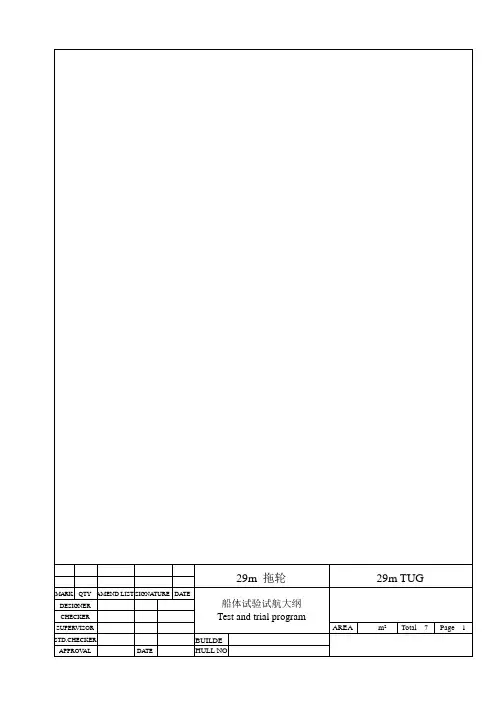
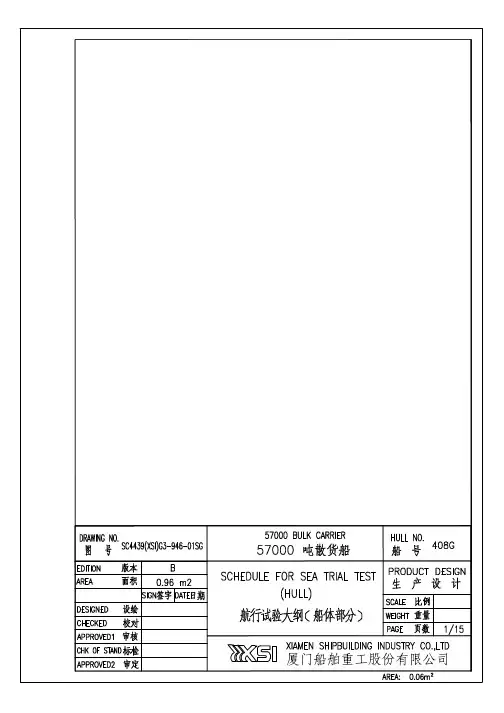
1. ST-H-01 TEST of SPEED 航速的测定1.1 The speed will be carried out by a specialized organization, and tested by DGPS Service System. Maxallowable sea state: ≤5 grades. Wind not to exceed 6 beafaut.航速的测定将由授权的专门机构进行,采用DGPS服务系统来完成。
最大允许的天气状况:海况≤5级, 风力≤浦氏6级。
The speed of the vessel should be tested in ballast condition: Ballast condition no need to be verified if no ballast pump are used, during sea trials. Confirmation by reading of remote draught sensor fore moulded draught about 4.90 m, aft moulded draught about 6.50 m is sufficient. Fore draft, mid draft and aft draft need to be read from ECR computer of draft remote measure system .and need to be recorded before speed test.While speed test, the water depth at least 50m, straight sailing course. The test result should be amended according to the weather condition by specialized measure speed organization if necessary.本船航速测定须在压载状态下进行,假如试航过程中没有压载泵被使用,可以直接认可试航时确认的压载状态。
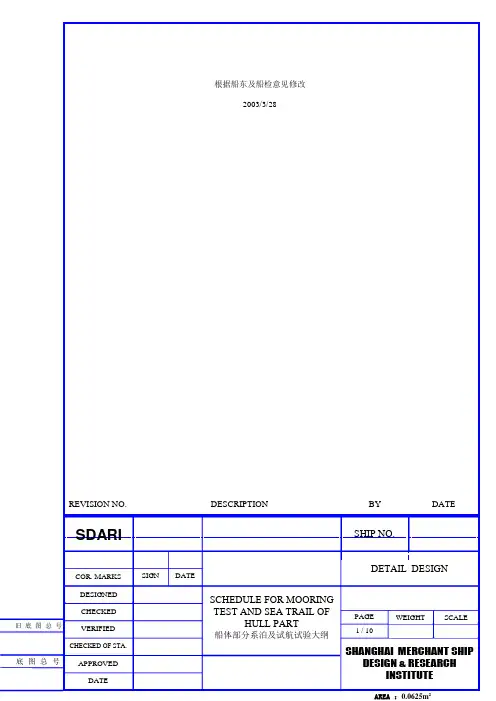
根据船东及船检意见修改2003/3/281 / 10PAGEWEIGHTSCALE底 图 总 号旧 底 图 总 号DETAIL DESIGNSHIP NO. SHANGHAI MERCHANT SHIPDESIGN & RESEARCHINSTITUTESCHEDULE FOR MOORING TEST AND SEA TRAIL OFHULL PART船体部分系泊及试航试验大纲SDARIDATESIGNCOR. MARKS DATEDESIGNED CHECKEDVERIFIEDAPPROVED CHECKED OF STA.REVISION NO. DESCRIPTIONBYDATE旧底图总号CONTENTI SEA TRIAL OF HULL PART (3)I-1GENERAL (3)I-2T EST C ONDITION AND P LACE (3)I-3P ROGRESSIVE S PEED T RIAL (S EE T ABLE H-1) (3)I-4I NERTIA T EST(O NLY H1008),C RASH S TOP A STERN T EST AND C RASH S TOP A HEAD T EST(O NLY H1008) 4I-5T URNING C IRCLE T EST (O NLY H1008)(S EE T ABLE H-5) (5)I-6Z IGZAG M ANEUVERING T EST (S EE T ABLE H-6) (5)I-7C OURSE K EEPING T EST (S EE T ABLE H-7) (5)I-8S TEERING G EAR T EST (S EE T ABLE H-8) (6)I-9W INDLASS AND A NCHORING T EST (S EE T ABLE H-9) (6)I-10S TRUCTRURE TEST (7)I-11M EASUREMENT OF V IBRATION (S EE T ABLE H-10) (7)I-12N OISE M EASUREMENT (S EE T ABLE H-11) (7)I-13W ILLIAMSON T URN T EST(O NLY H1008) (8)I-14R ESCUE BOAT AND LIFE BOAT LAUNCHING TEST (S EE T ABLE H-12) (8)II SEA TRIAL OF MACHINERY PART (9)II-1.M/E STARTING TEST AND AUXILIARY BLOWER AUTO-STARTING / STOPPING TEST(MOORING TEST IF POSSIBLE) (9)II-2.M/E LOAD TEST AND F.O. CONSUMPTION MEASUREMENT (9)II-3.M/E M.D.O.&H.F.O. CHANGEOVER TEST (10)II-4.M EASUREMENT OF M/E LOWEST STEADY REVOLUTION(S EE T ABLE M-7) (10)II-5.M/E REVERSING TEST(S EE T ABLE M-8) (10)II-6.T EST FOR COMPOSITE BOILER (EXHAUST GAS SECTION)(S EE T ABLE M-9) (10)II-7. F.W. GENERATOR TEST (S EE T ABLE M-10) (11)II-8.S HAFTING TORSIONAL VIBRATION MEASUREMENT (11)II-9.A/E OPERATION TEST BY H.F.O. AND M.D.O.&H.F.O. CHANGEOVER TEST (11)II-10.R EMOTE CONTROL OF M AIN E NGINE TEST. (11)II-11.E NGINE SIDE EMERGENCY MANEUVERING (14)II-12.A UTOMATIC UNMANNED ENGINE ROOM’S FUNCTION TEST (14)II-13. B ALLAST PUMPING TEST TO PROVE PUMPING VAPACITY AND EFFICIENCY DURING TRANFERING BALLAST WATER (15)II-14.O VERHAULING FOR M/E (15)III.SE A TRIALS OF ELECTRIC PART (16)III-1R ADIO &N AVIGATION AND I NTERIOR C OMMUNICATION E QUIPMENT(S EE T ABLE E-1) (16)III-2M AIN P OWER S TATION B LACK-O UT T EST(S EE T ABLE E-2). (17)III-3T HE PUBLIC ADDRESS, GENERAL ALARM & FIRE ALARM SOUND TEST (S EE T ABLE E-3). (17)III-4M.G.P.S T EST(S EE T ABLE E-4) (17)III-5I.C.C.P T EST (S EE T ABLE E-4) (17)III-6I NTERNAL COMMUNICATION SYSTEM(S EE T ABLE E-5) (17)III-7A LL ANGLES OF VISIBILITY FOR SIGNAL AND NAVIGATIONAL LIGHTS AS REQUIRED IN COLREGS ARE TO BE VERIFIED. (17)Ⅲ-8D EAD SHIP START(O NLY H1008)(S EE T ABLE E-6) (18)Ⅲ-9E LECTRIC LOAD MEASUREMENT (SEE T ABLE E-8) (18)底图总号旧底图总号main engine has run at stable outputs before the speed measurement commences. During speed measuring within test section course deviation shall be not more than 2 degrees, steering angle shall be not more than ±5 degrees.(4)Speed-measuring methodThe trial speed is to be measured by DGPS. The output shaft power and revolution of main engine to be measured by torsion meter. The instruments which used in the test should have the certification of verification before speed trials.(5)Measurement recorda.Test time and water depth of every trip.b.Wind velocity and direction, weather condition.c.Ship’s speed, revolutions, power of M/E (rpm) and indicator horsepower of every trip.(6)Ship’s speed calculationShip’s speed at design dra ft (16.5m) to be obtained from the following formula:V TD = V TB * V MD / V MBin the formula:V TD –actual speed at design draft.V TB –actual speed at ballast draft.V MD –model test speed at design draft inV MB –model test speed at ballast draft.I-4 Inertia Test, Crash Stop Astern Test and Crash Stop Ahead Test(1)Inertia Test (Only H1008) (See Table H-2)When ship is going full ahead at normal rpm (86.2 r/min), give an order to stop main engine. When ship’s speed reduces to the speed abt. 5kn the test is finished. During the test the course heading should be kept by changing the rudder angle. Measure and record the distance and time from the order of stop M/E to the ship’s speed reduce to 5kn.(2)Crash stop astern test (See Table H-3)When ship is going full ahead at normal rpm (86.2 r/min), give an order to make main engine run astern (63r/min). When ship’s speed reduces to the speed abt. 0kn the test is finished. During the test keep rudder angle at 0 degree. Measure and record the distance and time from command full astern to the ship’s speed reduce to 0kn.(3)Crash stop ahead test (Only H1008) (See Table H-4)When ship is going astern with 63r/min of main engine, give an order to make main engine run ahead(86.2 r/min). When ship’s speed reduces to the spe ed abt. 0kn, the test is finished. During the test keeprudder angle at 0 degree. Measure and record the distance and time from command full ahead to the ship’s speed reduce to about 0kn.底图总号旧底图总号I-5 Turning Circle Test(Only H1008) (See Table H-5)(1)Test methodWhen the steering gear is in the condition of double pump working, the test should be done at full speed (91r/min), harbor full speed (68r/min)and harbor half speed(55r/min)respectively:a.The rudder angle is turned to hard starboard (35degree) and held until t he ship’s heading anglechanges to 540 degree, the test is finished.b. Resume the straight course until the speed recovery.c. The rudder angle is turned to hard portside (35degree) and held until the ship’s heading anglechanges to 540 degree, the test is finished.d. Resume the straight course until the speed recovery.(2)Measurement record the transfer distance, advance distance, turning diameter and maximum heelingangle.I-6 Zigzag Maneuvering Test (See Table H-6)(1)Test methodWhen the vessel is running ahead (91r/min), the test is to be carried out in accordance with following steps:a.The rudder angle is turned from its zero position to 10︒ starboard and held until the course of thevessel changes to an angle of 10︒ starboard to the original course;b.The rudder angle is turned from 10︒ starboard to 10︒ port and held until the course of the vesselchanges to an angle of 10︒ port to original course;c.The rudder angle is turned from 10︒ port to 10︒ starboard and held until the course of the vesselchanges to an angle of 10︒ starboard to original course:d.The rudder angle is turned from 10︒ starboard to its zero position and held until the vessel runs inoriginal course.(2)Measurement recorda.M/E revolution.b.Initial vessel speed.c.Time of every stage and course angle.I-7 Course Keeping Test (See Table H-7)During sea trail, check the course stability:(1)Keep the steering tiller unchanged while the vessel is sailing full ahead (91r/min) with steering by hand.Record the reading of GYROCOMPASS with the interval of 30 seconds. Measurement will be continued for 3 minutes, one time for fair and counter current respectively.(2)The vessel is sailing full ahead (91r/min) and to be ensured to keep the course. Measure the times ofsteering for keeping the course and the max. Rudder angle. Measurement will be continued for 3 minutes, one time for fair and counter current respectively.底图总号旧底图总号I-8 Steering Gear Test (See Table H-8)(1)Main engine is controlled in wheelhouse, and maneuver handle to be put in the position of ahead andfull speed (91r/min). Steering test to be done in wheelhouse. Operate the hydraulic pump No.1 or No.2 respectively, do the test by putting the rudder angle from 0︒ to 35︒ starboard/from 35︒ starboard to 35︒ port/form 35︒port to 0︒/from 0︒ to 35︒ port/from 35︒ port to35︒ starboard/from 35︒ starboard to 0︒. Measure ship’s heeling angle. The time required to put the rudder from 35︒of one side to 30︒of another side shall not exceed 28 second.(2)Main engine to be put on the status of ahead and full speed, running two hydraulic pumps, test thecapability of putting the rudder from 0︒ to 35︒ starboard/from 35︒starboard to 35︒port/form 35︒port to 35︒starboard/ from 35︒starboard to 0︒.Following data to be recordeda.Weather, sea condition.b.Time required for each moving rudder.c.Maximum oil pressure in hydraulic cylindersd.Maximum current of motor.(3)Emergency steering gear testTo test the emergency steering effectiveness in stee ring gear room with ship’s running at half speed (M/E abt 76r/min) but not less than 7Kn.By turning the pump control handle make the rudder angle changed from 0︒ - 15︒ starboard - 15︒ port - 0︒one time. Measure the time of steering from 15︒ starboard to 15︒ port. It should not exceed 60 second.(4)Auto pilot effectiveness testDuring the main engine endurance test, do the test with No.1&No2 steering system respectively.--NFU (manual) steering--HAND (following) steering--AUTO (automatic) steeringSet up a heading course, navigate with auto pilot, and observe the keeping course capacity with course recorder. Then do the test of changing heading course.I-9 Windlass and Anchoring Test (See Table H-9)(1)An anchor-ground with more than 82.5 meter depth shall be selected under a calm sea condition and thebow in the upwind.(2)Each anchor is to be let go down gradually to the surface of the water.(3)Five shots of chains of one side anchor is to be let go down freely. During this process manually brake.Check the reliability of the brake system.(4)One side anchor is to be hoisted. During hoisting process, average speed of hoisting anchor to bemeasured and recorded. (by measuring No.2 and No.3 shot of chain ) , The average speed is not less than 9m/min. Then hoist the anchor up to bell mouth with windlass.底图总号旧底图总号2.3.2 The report on chemical analysis and low calorific value to be submitted before this test.2.3.3 The ship should go straightly as possible during the F.O. consumption measurement.2.3.4 The measured F.O. consumption should be corrected according to the actual calorificvalue and ambient conditions, then be offered to owner for reference. (See Table M-6)2.4 M/E shaft power to be measured when F.O. consumption is measuring.II-3.M/E M.D.O. & H.F.O. changeover testM/E M.D.O. & H.F.O. changeover test to be executed as follows:M.D.O. --- H.F.O.(before M/E operating test for adjustment)H.F.O. --- M.D.O.(after M/E load test)II-4.Measurement of M/E lowest steady revolution(See Table M-7)M/E is adjusted to the lowest steady revolution by reducing revolution progressively atwhich the engine keep running for 5 minutes. Record the revolution of M/E andturbocharger, the graduation of the maneuvering handle and M/E fuel oil pump.Turnrudder angle to hard portside (35degree), observe change of the course.II-5.M/E reversing test(See Table M-8)M/E reversing test should be carried out while the engine running at the lowest steadyrevolution. The time for reversing should not be more than 15 seconds. The testincluding … ahead –astern‟ and …astern –ahead‟ is not less than 3 times.II-6.Test for composite boiler (exhaust gas section) (See Table M-9)6.1 During M/E load test at NCR, the measurement of the evaporation of the compositeboiler (exhaust air section) to be conducted for one hour by flowmeter arranged at thedelivery side of the feed water pump. During evaporation test, composite boiler(oil-fired section) should not operate and the feed water to be kept stable.6.2 The soot blower of boiler to be tested.6.3 the safety valve popping test: Opening pressure of safety valve: 0.8 MPa6.4 Pressure accumulation test(The items tested at the mooring test stage will not be triedagain)The boiler pressure is not to rise more than 0.954 Mpa (6% above the maximum allowable working pressure) when the steam stop valve is closed under full firing condition for duration of 15 minutes. During this test no more feed water is to be supplied than that necessary to maintain a safe working water level.底图总号旧底图总号II-7.F.W. generator test (See Table M-10)7.1 During M/E NCR condition, F.W. generator to be running for one hour utilizing thewaste heat in the jacket cooling fresh water from M/E. Record the parameters asfollows:a)Vacuum and temperature of evaporation chamberb)Temperatures of cooling fresh water inlet and outletc)Temperatures of sea water inlet and outletd)Salinity in the distilled watere)Capacity(not less than 25 m3/24h,at NCR)f)Delivery pressure of sea water ejector pumpg)Delivery pressure of ejector7.2 In condition of voyage at low speed, F.W. generator to be running for function test withsteam(if some F.W. in outlet the test finished ).II-8.Shafting torsional vibration measurementThe test to be carried out from M/E lowest steady revolution to 91.0 r/min at intervals of5 r/min, and from 91.0 r/min to M/E lowest steady revolution at intervals of 5 r/min.Example: lowest steady revolution→30→35→40→45→55→60→65→70→75→80→85→91 r/min→lowest steady revolution。
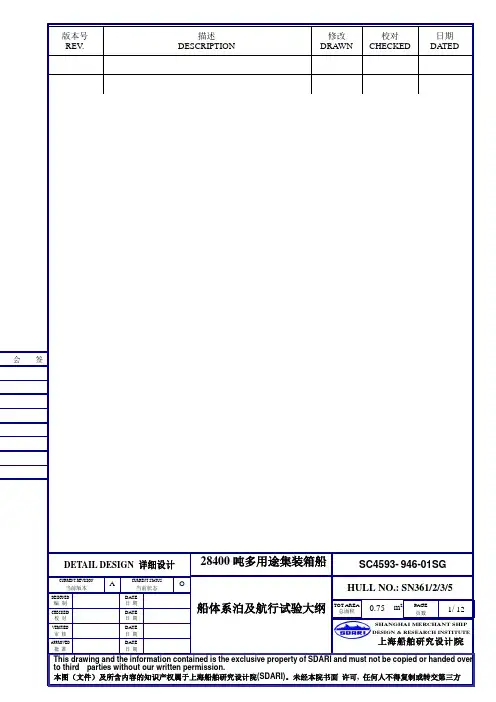
总述1.本大纲按照《海船系泊及航行试验通则》GB/T 3471-1995的要求编制。
2.本大纲包括系泊试验及航行试验,涉及电气和轮机的内容,请查找相应文件。
各项目的试验程序由负责船舶建造的管理部门决定。
3.在各项目试验开始前,各有关人员应熟悉该项目的使用说明书及相关的施工设计图纸。
4.试验应在所有系统及辅助设备完工后进行。
5.系泊试验及航行试验所使用的测试设备和仪器,应具有国家有关主管机构签发的有效合格证件。
对与法定和船级检验有关项目的测试设备和仪器,执行检验的单位有权检查其精度等级、定期鉴定的书面文件或记录。
6.本大纲所包括的各设备以及与其相关联的各系统可以同时进行试验。
7.试验需由船级社验收时,应通知船检参加,涉及到设计性能的试验项目,应通知设计单位参加。
8.船东代表可参加所有项目的试验。
9.每个项目的试验结果,应符合适用的法规、规则、公约、规范或标准的规定。
10.航行试验前,应按验船部门同意的标准进行倾斜试验,其试验报告应经验船部门批准认可。
11.航行试验前,船厂应消除系泊试验中发现的故障、缺陷,并取得验船部门签发的试航证书。
12.试验结果由船厂质检处检验员记录于规定的表格上。
试验结束后,船厂应整理出有关技术文件和试验报告,并作为检验和交船的必须技术文件,提交给验船部门和用船单位。
13.本大纲试验项目的要求,适用于续造的姊妹船。
第二部分航行试验1.概述1.1本航行试验大纲,各项目的试验程序由负责船舶建造的管理部门决定。
1.2本大纲试验项目的要求,适用于首制船及续造的姊妹船。
1.3在各项目试验开始前,各有关人员应熟悉该项目的使用说明书及相关的施工设计图纸。
1.4本大纲所包括的各设备以及与其相关联的各系统可以同时进行试验。
1.5试验需由船级社验收时,试验记录须经船级社验船师过目。
1.6船东代表可参加所有项目的试验。
1.7试验结果由船厂质检处检验员记录于规定的表格上。
1.8海上试航所涉及的机电设备须先行在码头试车结束。

36.60m玻璃钢延绳钓渔船36.60m FRP LonglineFishing Boat标记数量修改单号签字日期系泊、航行试验大纲Mooring,Sea Trial Test Outline XG8301-946-01编制打字校对标检总面积0.54m2共9页第1页审核威海西港游艇有限公司审定日期一、总则general1 本大纲根据《钢质海洋渔船建造规范》(1998)有关项目并结合具体情况拟定,作为本船交船试验的依据。
试验目的是考核建造质量是否满足施工图纸设计要求和渔船建造规范,是否满足安全生产的要求等有关规定。
本船建成后,应按本大纲进行系泊试验和航行试验,同时还应满足现行船舶规范,船舶检验规则、规程This outline is built according to the relevant terms in "Steel Marine fishing boat construction rules" (1998) and combined with the specific situation, which will be as the basis of the ship trial test. The test purpose is to evaluate if the construction quality meets the design requirements of the construction drawings and the fishing boat construction specification, and whether it will meet the requirements of safety in production and other relevant provisions. After the completion of the vessel, it shall be carried out mooring test and sea trial test according to this outline, at the same time, it should also meet the current vessel specification, boat inspection regulations and rules.2 本大纲规定的各种试验项目,船厂应通知用船单位参加试验和验收。
External Fire-figthing test外消防测试1.1Start procedure(启动程序):∙Switch on the control system接通控制系统∙Move the monitors into a safe position where barrel is pointing away from the vessel.将消防炮朝向船外,确认在消防炮移动角度范围内没有阻碍物。
∙Drop the dedicated engine 1 to 550 rpm将#1发电机降速到550 rpm∙Open the fire pump sea suction valve ( if closed in std-by)打开消防泵的海水吸入阀。
∙FIFI pump discharge valve to be closedFIFI泵的出口阀关闭。
∙Open the overboard discharge valve打开排舷外阀。
∙By-pass around the discharge valve to be opened , recommended being open all the time出口阀的旁通阀打开(可以与舷外阀同时打开)。
∙Switch the control system to on by means of switch on the main control cabinet and on joystick panel ( in the wheelhouse)接通主控制箱及操纵板(驾驶室).∙Open shut valve between pump and ejector if any如有可能打开FIFI泵与甲板上喷射枪的之间的阀门。
∙Start the pump by clutching in. Note engagement speed (Typically 450 to 650= idle speed ) and fire fighting engine speed (Typically 720 to 1800rpm). In case of emergency the pump and step-up gear are able to clutch in at full speed.启动FIFI泵,注意啮合时速度(发电机处于怠速状态450 to 650rpm )。
一、船体部分航行实验sea trials for Hull part1.航速试验(船装计程仪法):speed trials(log to be provided on board)a.试验条件sea trials condition:试验海区有足够的助航距离和回旋余地。
sea trial area to be larger enough for navigation and making circle.风力不超过蒲氏4级,海浪不超过3级,潮流平稳。
wind speed to be not over Beaufort 4 grade, wave not over 3 grade, tide smoothly在压载状态下测速。
The tug to be tested speed in ballast conditionb.试验内容及程序:sea trials content and procedure一次双程往返,主推进马达100%转速(1600rpm)。
One double trip at M/E 100% revolution(1600rpm)一次双程往返,主推进马达90%转速(1440rpm)。
One double trip at M/E 90% revolution(1440rpm)一次双程往返,主推进马达75%转速(1200rpm)。
One double trip at M/E 90% revolution(1200rpm)2.停船试验stopping trials:a.试验条件:sea trials condition试验海区有足够的助航距离和回旋余地。
sea trial area to be larger enough for navigation and making circle.风力不超过蒲氏4级,海浪不超过3级,潮流平稳。
wind speed to be not over Beaufort 4 grade, wave not over 3 grade, tide smoothly在压载状态下测速。
目录1、船体部分1.1 总则1.2 测速试验1.3 回转试验1.4 停船试验1.5 全速停车倒退和前进试验1.6 航向稳定性试验1.7 艏侧推试验1.8 船体结构振动测量1.9 抛锚试验1.10 操舵试验1.11 噪声测试2、轮机部分2.1 主机最低稳定转速试验2.2 主机负荷试验2.3 可调桨液压系统操纵速率试验2.4 制淡装置试验2.5 废气锅炉试验2.6 主机燃油转换试验2.7 测量轴系扭振2.8 测量主机轴功率2.9 检查齿轮箱负荷2.10 自动化试验2.11 桥楼遥控操纵试验3、电气部分3.1 失电试验3.2 通导设备试验3.3 主机转速表及螺距指示器调整3.4 电力负荷测量3.5 瘫船启动状态1. 船体部分1.1 总则1.1.1 本试验大纲系根据合同附件主要规格书编制。
1.1.2 本试验大纲应提交船级社和船东代表确认。
1.1.3 试航状态:船处于压载状态。
1.2 测速试验1.2.1 地点和测量方法:地点:长江口。
方法:测量船舶在通过测速柱间距离(1海里)时所需时间。
1.2.2 试航状态和天气船状态:平均吃水:约4.1m;排水量:约4877.1t。
天气条件:风力在蒲氏2~3级,静潮平流。
1.2.3 测试工况测量0.5、0.75、0.9及1.0主机功率(不带轴带发电机)下,船的航速,并按下列公式求出航速:V=(V1+V2)/2 海里/时式中:V――平均航速,海里/时;V1――第一次单程航速,海里/时;V2――第二次单程(返回)航速,海里/时;注:航速需经浅水阻力修正。
1.2.4 测量记录――试验数据和试验地点;――试验区域水深;――试验区域水比重;――艏、舯、艉吃水;――海况、水流方向、天气;――相对风速和风向(由风速表和风向仪测量);――船航向(每次航行由罗盘测定);――船经过测量区域的时间(用秒表);――用扭力仪测量主机轴功率(仅首制船进行测定);――在航速试验同时,校正计程仪初始数据。
+QS20060308BELUGA CAPE TOWN中文试航大纲编制:审校:翻译:定稿:概要海试准备出发前,船舶应处于航行工作状态。
下列一些项目应得到船东和船级社确认:救生、消防设备上船到位航行、雷达、信号灯等设备应处于正常工作状态机舱、甲板机械处于良好的工作状态所有的报警系统应测试并处于工作状态所有的舱口都应防水压载状态:船舶进行合理的压载,首吃水5.8 m,尾吃水6.45 m,排水量为16382 t.(海水比重1.025t/m3,尾倾1.2m) 读两舷首、中、尾的吃水在码头,校准测深仪并同在首部手动测量的结果进行比较在海试期间下列系统应该处于工作状态导航、雷达系统;空调及通风系统;冷藏系统;燃油、滑油系统;火灾探测报警系统;压载水系统(如需要);货舱通风;货舱烟气探测。
所有的记录应提交给船东和GL1. 船体部分下列数据应该确认并记录试航时间和地点试航海区的水深海况和天气状况风速和风向大气温度1.1航速测定测量方法用DGPS测量速度,每种工况下的航速是在相应主机负荷下单程航速的平均值,同时应考虑航程中潮汐顺流和逆流的影响。
(每个单程的航程不少于2海里)测试程序在海试中,在轴带发电机不工作的情况下,.速度应根据下列表格主机的0.25,0.5,0.75,0.90,1.0MCR 负荷进行测试,如下表。
舵角尽可能保持在零位,最大运用舵角不能大于3°每个平均速度应按照下列公式得出.44 32 1V VVVV+ ++=注意:速度应按照水深、风速、风向、航向、水流等得到修正。
在测试期间,计程仪应同时进行校正。
记录应由船厂准备。
1.2 回转测试测试条件主机负荷为100%MCR(全速前进)。
在全速前进的情况下,左满舵转360度,右满舵转360度。
记录回转时间和回转尺寸。
1.3 Z型测试测试方法主机负荷为90%MCR(全速前进)。
Z型测试是检测船舶的应舵性,是通过左/右交替操舵使船舶偏离原始航向10︒/10︒、20︒/20︒来完成的。
一、船体部分航行实验sea trials for Hull part1.航速试验(船装计程仪法):speed trials(log to be provided on board)a.试验条件sea trials condition:试验海区有足够的助航距离和回旋余地。
sea trial area to be larger enough for navigation and making circle.风力不超过蒲氏4级,海浪不超过3级,潮流平稳。
wind speed to be not over Beaufort 4 grade, wave not over 3 grade, tide smoothly在压载状态下测速。
The tug to be tested speed in ballast conditionb.试验内容及程序:sea trials content and procedure一次双程往返,主推进马达100%转速(1600rpm)。
One double trip at M/E 100% revolution(1600rpm)一次双程往返,主推进马达90%转速(1440rpm)。
One double trip at M/E 90% revolution(1440rpm)一次双程往返,主推进马达75%转速(1200rpm)。
One double trip at M/E 90% revolution(1200rpm)2.停船试验stopping trials:a.试验条件:sea trials condition试验海区有足够的助航距离和回旋余地。
sea trial area to be larger enough for navigation and making circle.风力不超过蒲氏4级,海浪不超过3级,潮流平稳。
wind speed to be not over Beaufort 4 grade, wave not over 3 grade, tide smoothly在压载状态下测速。
The tug to be tested speed in ballast conditionb.船舶保持正舵,测定主机在半速正车、全速正车情况下自停车令发出至船舶停止前进时船舶滑行距离和滑行时间以及观察船舶方位变化。
With the vessel proceeding ahead on a straight course at full power and half power themain engine controls are to be moved from ‘full ahead’ to ‘stop’ and the followingrecords taken:1)Time to move controls from ‘full ahead’ to ‘stop’2)Estimate of distance run between initiation of order and stopping of vessel.3)Change of ship azimuth.c.船舶保持正舵,测定主机在半速倒车、全速倒车情况下自停车令发出至船舶停止后退时船舶滑行距离和滑行时间以及观察船舶方位变化。
With the vessel proceeding astern on a straight course at full power and half power the main engine controls are to be moved from ‘full astern’ to ‘stop’ and the following records taken:1)Time to move controls from ‘full astern’ to ‘stop’2)Estimate of distance run between initiation of order and stopping of vessel.3)Change of ship azimuth.3.回转性试验:turning performancea.试验条件:trials condition试验海区有足够的助航距离和回旋余地。
sea trial area to be larger enough for navigation and making circle.风力不超过蒲氏4级,海浪不超过3级,潮流平稳。
wind speed to be not over Beaufort 4 grade, wave not over 3 grade, tide smoothly在压载状态下测速。
The tug to be tested speed in ballast conditionb.船舶在主推进马达90%转速(1440rpm)下,在预定航向上稳速直航2~3min,按规定操舵至35º或允许最大舵角,待船首向角变化达到540º时,即一个回转试验结束。
测定回转直径、时间和最大横倾角。
按相同程序反方向操舵进行下一个回转试验。
c.在回转过程中,连续记录时间、航速、首向角、横倾角,测量船舶在转动90º、180º、270º、360º时所需时间和坐标。
4.侧向推进器试验bow thruster trials船舶为零航速时:开动首侧推,在其最大功率时,测量船首向角变化,记录时间,连续试验3~5min;船舶为低航速时:将舵置于满角,开动首侧推,在其最大功率时,测量船首向角变化,记录时间,连续试验3~5min;5.操舵试验Steering Trials(1)条件:与航速试验同。
Condition: steering trials is to be carried out in conjunction with speed trials.(2)船舶前进(主机转速约1200 rpm)时,在驾驶室按下图操纵舵桨:With the vessel proceeding at M/E 1200rpm, the helm to be operated in wheelhouse according to the following drawing:记录从一舷35°到另一舷35°所需时间,及船舶的最大横倾角。
A total time taken to complete the manoevre: from 35 degrees port to 35 degreesstarboard t, is to be recorded. The max. bank angle to be also recorded.机旁操舵(应急舵)试验与上述试验相似,角度为15°The manoeuvring trials at local to be carried out same as the above and the rudder angle to be 15°.6. 航向稳定性试验course steady trials(1)舵角不变,测量航向变化:保持正舵全速不变,隔20S测量罗径读数,连续3~5 次。
顺水、逆水各1次。
Course change to be measured with anchor angle kept steady and course to be measured: with the vessel full ahead on straight course, the compass records to be taken every 20s for 3-5 times. The above trials to be carried out for one time in downstream and counter current respectively.(2)航向不变,测量操舵情况:在全速直航情况下,为保持航向不变,检测操舵次数和最大操舵角。
时间为3min,顺、逆水各1次。
Manoeuvring trials to be measured with steady course: with the vessel full ahead on straight course, the time of manoeuvring and max. manoeuvring angle for keeping course steady to be recorded. The trials to be lasted for 3 min. The above trials to be carried out for one time in downstream and counter current respectively7. 抛锚试验:anchoring testa.左锚、右锚分别抛出1次,在抛锚过程中刹车3次,检查刹车可靠性。
Port and starboard anchors are to be laid out for one time respectively, during this trials, brake reliability to be checked for three time.b.锚抛定后,用甲板挚链器定位锚链,再用微速倒车将锚链拉紧,检查挚链器的可靠性。
chain cable to be located by Deck chain cable stopper and to be tightened by slow astern. The stopper reliability to be checked.c.启动锚机收起左锚、右锚,破土后测量起锚速度。
锚收妥后,检查锚与船体的贴合情况是否良好。
Starting anchor windlass to lift Port & starboard anchors and speed record after breaking ground is to be taken. The condition of joint between anchor and hull to be checked after anchor to be in anchor pocket.d.在抛锚和起锚过程中应做如下检查:The following checks to be taken锚链和卸扣通过锚链筒、挚链器和链轮的情况,锚链通过链轮时应无过分跳动和翻链现象。